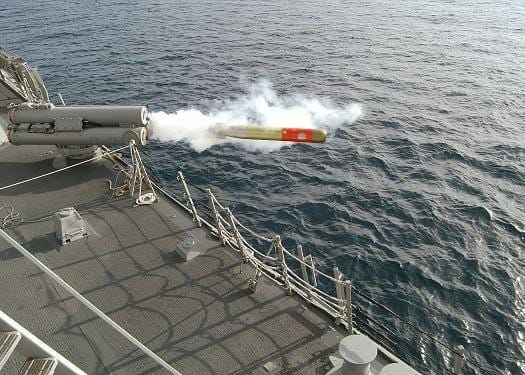Torpedoes
Torpedoes are explosive-laden projectile weapons used in both surface warfare and anti-submarine warfare (ASW). Torpedoes are launched underwater, by submarines or naval mines, or above the surface, by ships or aircraft. Historically, torpedoes have not been used much in the Persian Gulf.
- Basics of Torpedoes
- Iran and Torpedoes
- Why No Torpedoes in the Strait?
RESOURCES

Basics of Torpedoes
Source: http://www.news.navy.mil/view_single.asp?id=4963
Caption: An MK-46 lightweight torpedo being fired by a surface warship
There are three basic parts of a torpedo; 1) a propulsion system, 2) a guidance system, and 3) a warhead.[i] Once fired, modern torpedoes use either active or passive sonar to identify the target. Upon reaching the target, they typically dive under the keel of the target ship before they detonate. The explosion sends a shockwave into the target and also creates a gas bubble that may flex the target as it rises, perhaps breaking the target's keel.
The torpedo's effectiveness depends on the success of its guidance system. Bathymetric and underwater environmental factors (e.g., water temperature and underwater currents) can hamper the effectiveness a torpedo's targeting technology. Furthermore, typical warship targets may deploy countermeasures such as noisemakers (decoys) and jammers that may confuse the torpedo's homing device.
Iran and Torpedoes
In April 2006 Iran conducted a series of military exercises in the Strait of Hormuz. Iran claimed to successfully test the "world's fastest underwater torpedo," called the Hoot. The Hoot is a "supercavitating" torpedo with a special nose designed to reduce its drag and increase its speed.[ii] Virtually undetectable to ships' radar systems,[iii] a supercavitating torpedo allegedly achieves speeds four times faster than standard torpedoes. While Iran claims to have developed the Hoot, experts speculate that the torpedo may be a Russian-built Shkval acquired from China or Kyrgyzstan.[iv]
Iran has not used torpedoes in any past conflict. During the Tanker War in the late 1980s, the Iranian navy did not operate submarines, the traditional mechanism for torpedo use, nor did they attempt to use surface vessels or aircraft to fire torpedoes.
Why No Torpedoes in the Strait?
There are several reasons why torpedoes should not be viewed as a significant threat to oil flows through the Strait of Hormuz. First and foremost, only a large-warhead "heavyweight" torpedo has a realistic chance of significantly damaging a 200,000-ton VLCC.[v] But their size and weight limits the types of military platforms that can fire heavyweight torpedoes to submarines, aircraft, and larger surface combatants. U.S. naval and air superiority are likely to prevent Iran from risking head-to-head engagements by trying to fire heavyweight torpedoes at oil tankers from its few dedicated military platforms. Furthermore, Iran only owns three Kilo-class submarines, all with less than perfect operational histories. It is also unlikely that Iran would risk using its limited submarine resources in undersea warfare with the U.S.; surreptitious mine deployment is probably more likely.
Even if Iran possessed the necessary equipment and capabilities to fire heavyweight torpedoes, unusual sea floor clutter, complex thermal layers, and other bathymetric conditions in Persian Gulf waters severely hamper torpedos' targeting devices. [vi]
[i] E.W. Jolie, "A Brief History of U.S. Navy Torpedo Development," Newport Laboratory, (1978). Online. Available: http://www.hnsa.org/doc/jolie/index.htm. Accessed: October 21, 2007.
[ii] Polmar, Norman, Cold War Submarines: The Design and Construction of US and Soviet Submarines (2004).
[iii] Peter Godspeed, "Iran Flexes its Military Muscle: Holy Prophet war games serve as warning to West," National Post Canada (April 5, 2006), p. A13.
[iv] Ali Akbar Dareini, "Iran Says it Can Handle Any Invasion," The Associated Press (April 4, 2006).
[v] John R. Benedict, "The Unraveling and Revitalization of U.S. Navy antisubmarine warfare," Naval War College Review, 58.2 (Spring 2005), p. 29.
[vi] John R. Benedict, "The Unraveling and Revitalization of U.S. Navy antisubmarine warfare," Naval War College Review, 58.2 (Spring 2005), p. 29.


